Bloom’s taxonomy in designing comprehension questions for reading texts in EFL reading comprehension class
Bloom’s Taxonomy is a set of models used to classify educational
learning objectives into levels of complexity and specificity. It is usually used to
structure curriculum learning objectives, assessments and activities. In the paper, the
author introduces a general overview of the Cognitive Domain in Bloom’s Taxonomy
and suggests ways to use it in design comprehension questions for reading texts. With
a clear explanation about each level of comprehension as well as the application of
Bloom’s Taxonomy in teaching and learning reading skills, the paper can be a source
of reference for those who are really concerned about how to set reachable objectives
for their teaching and learning to improve students’ language competence in general
and reading comprehension skills in particular
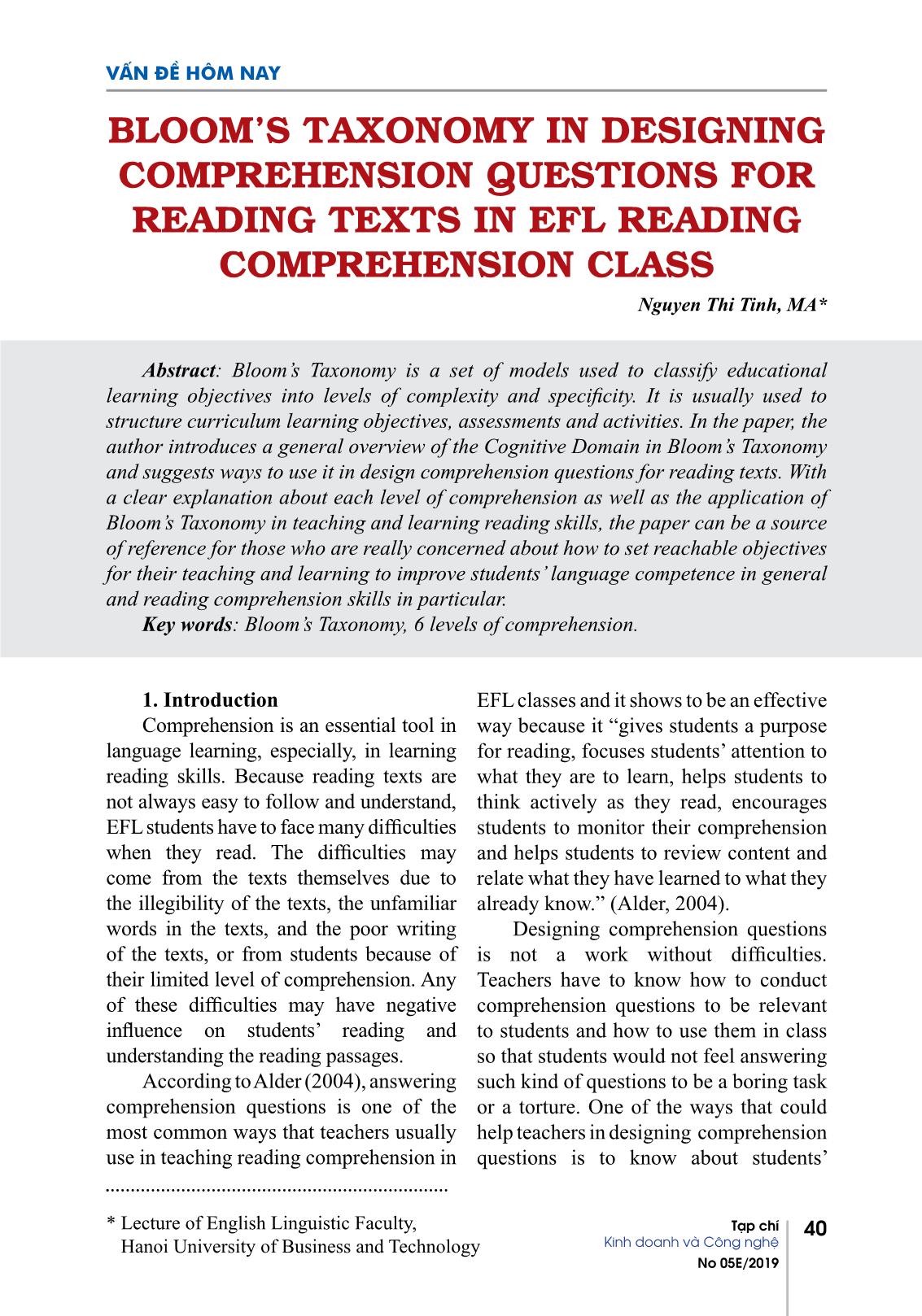
Trang 1
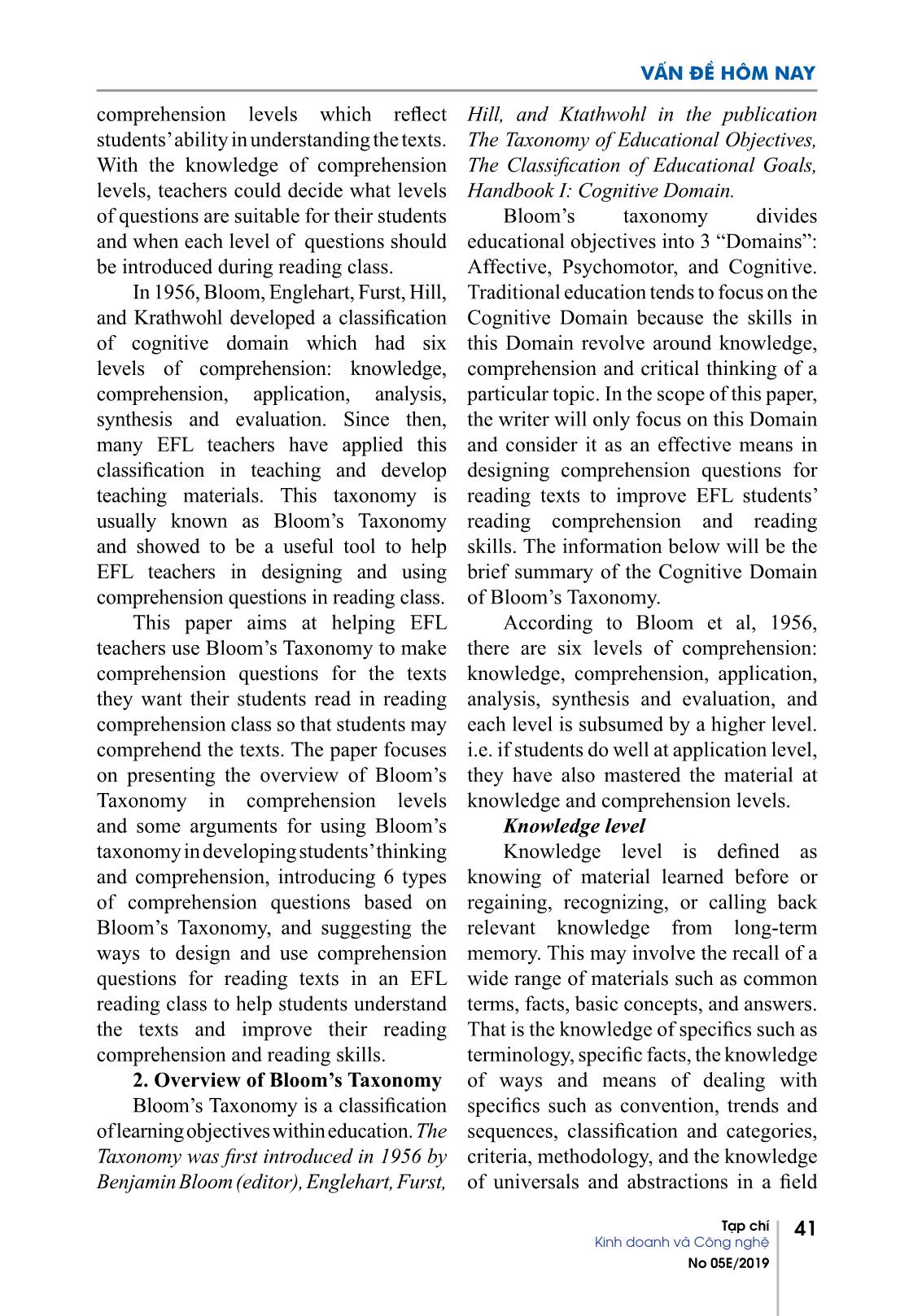
Trang 2
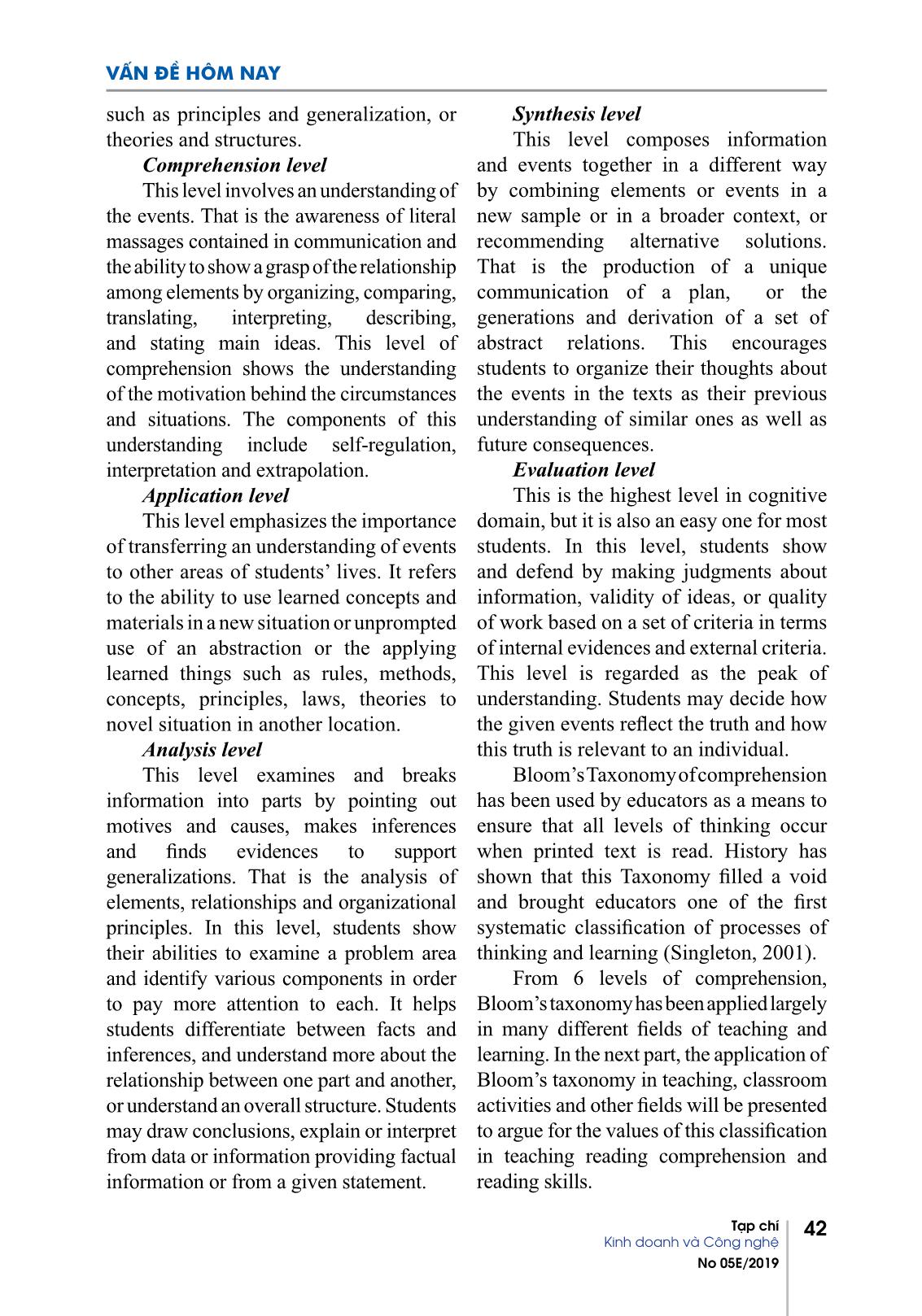
Trang 3
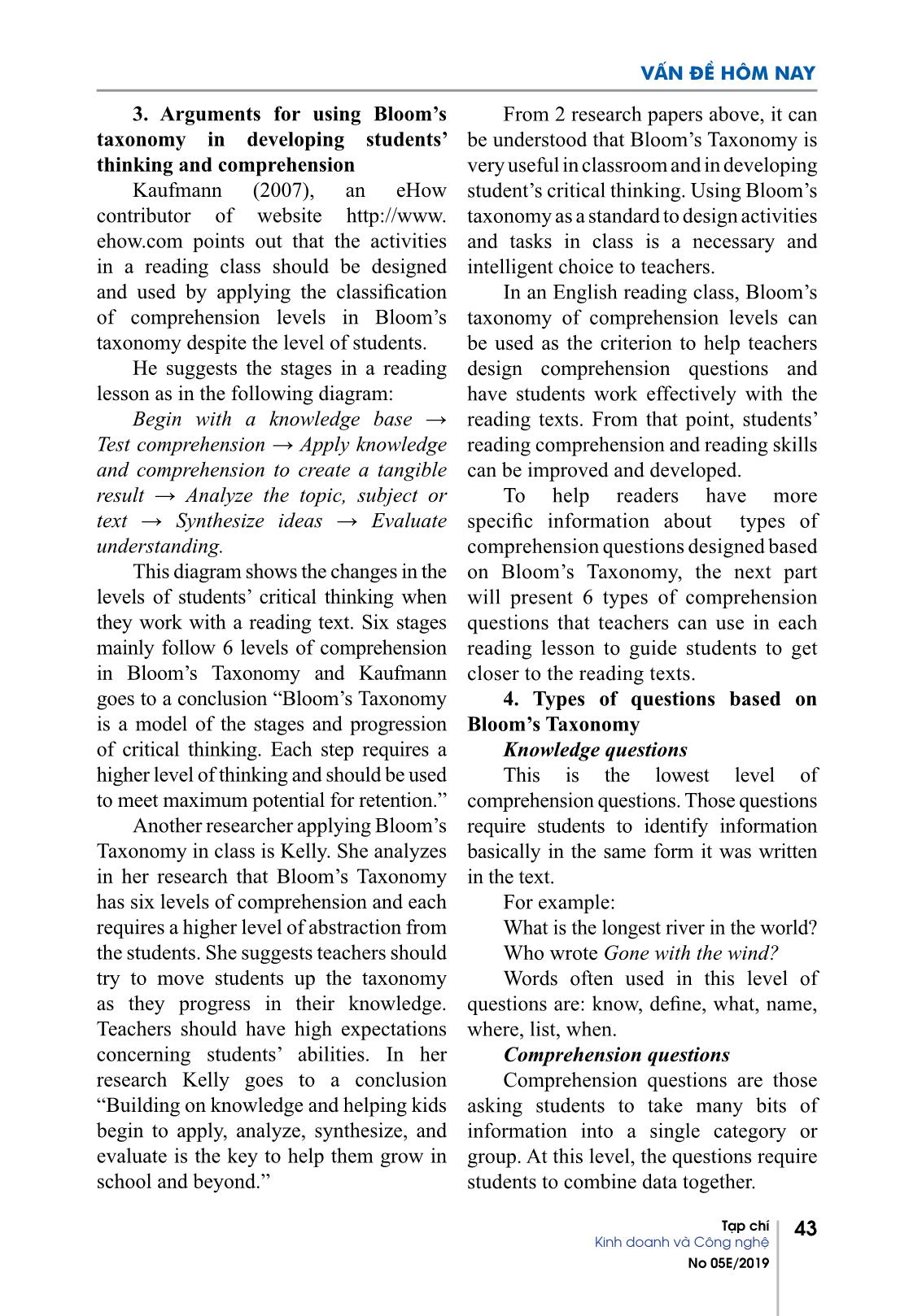
Trang 4
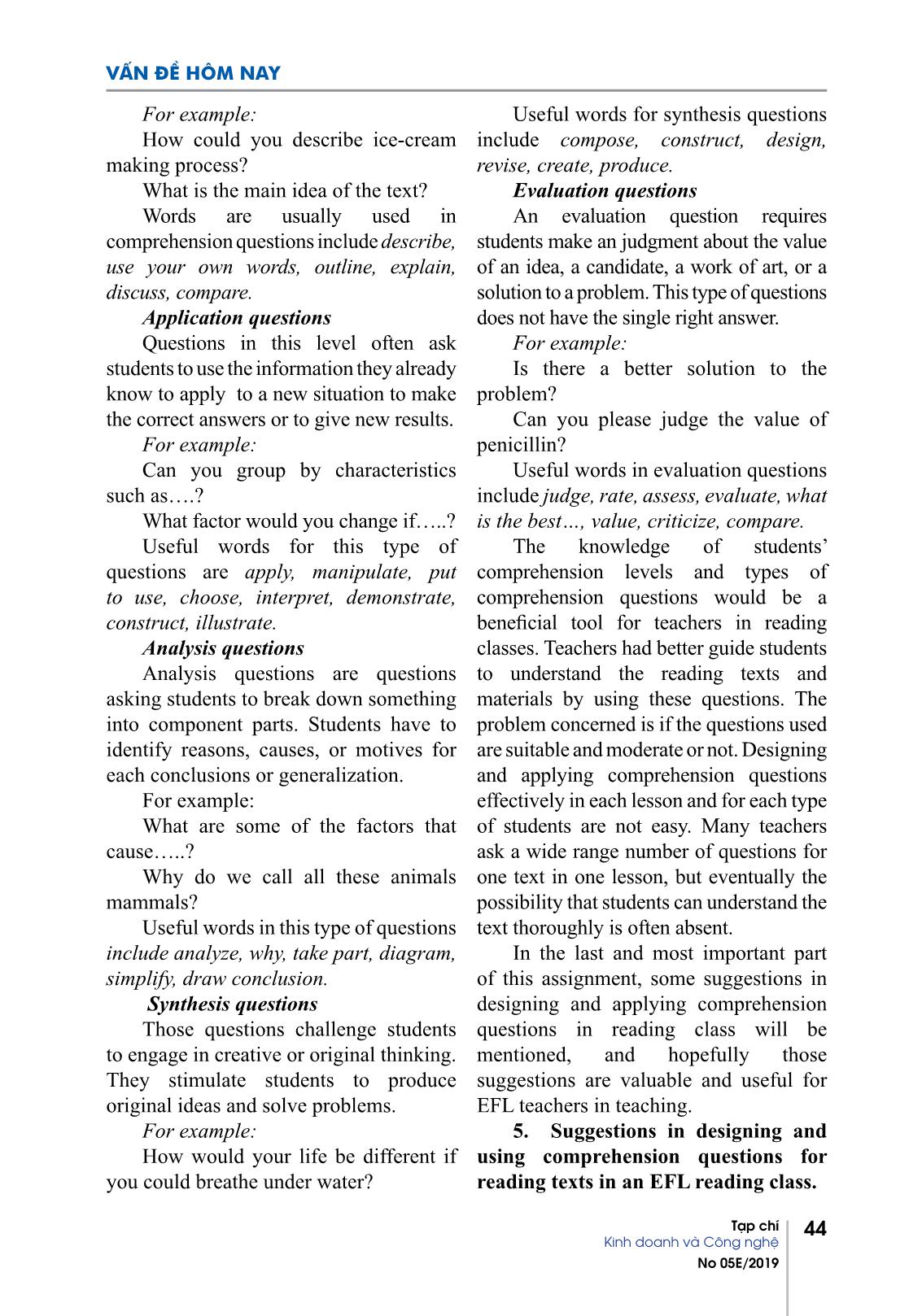
Trang 5
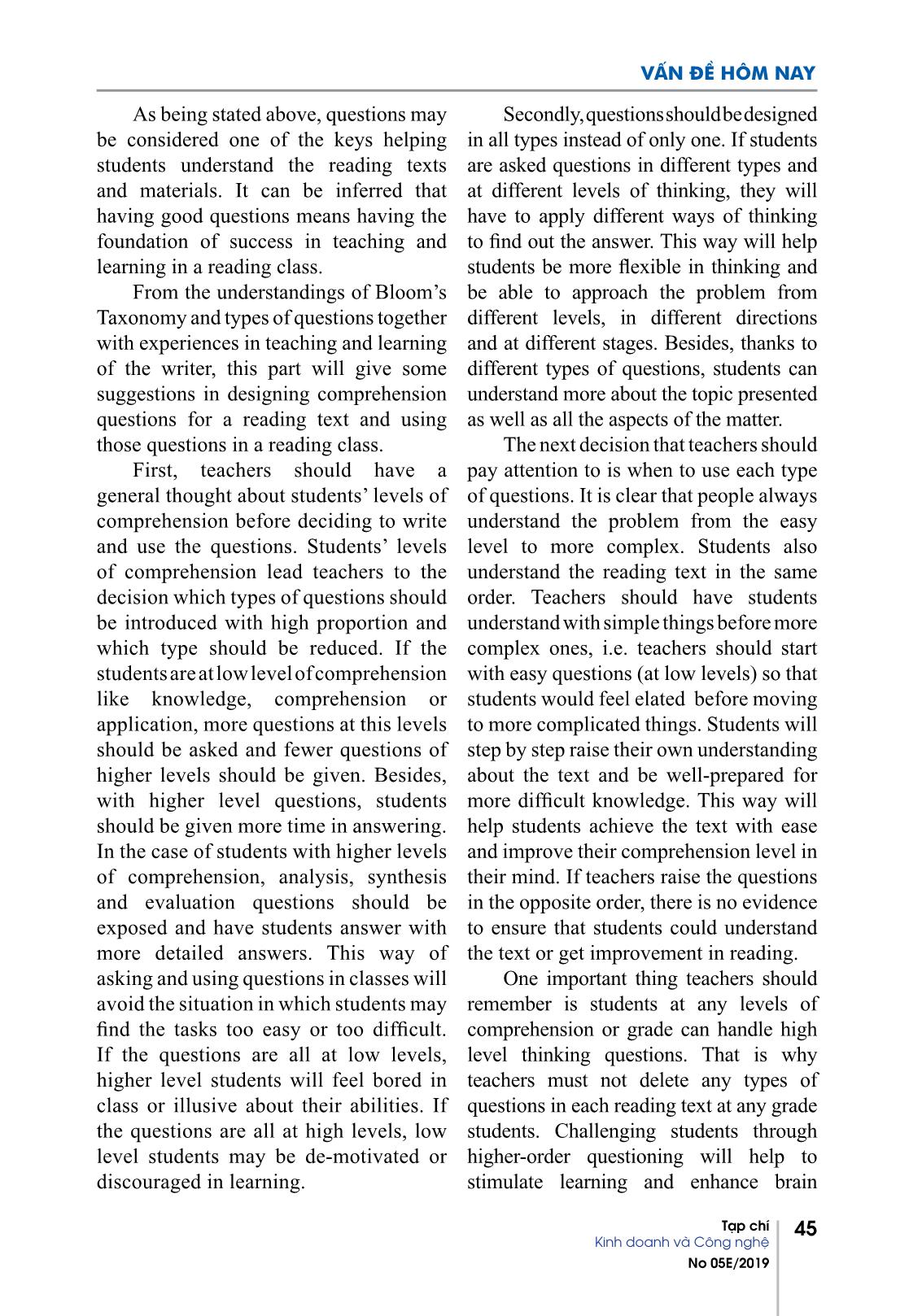
Trang 6
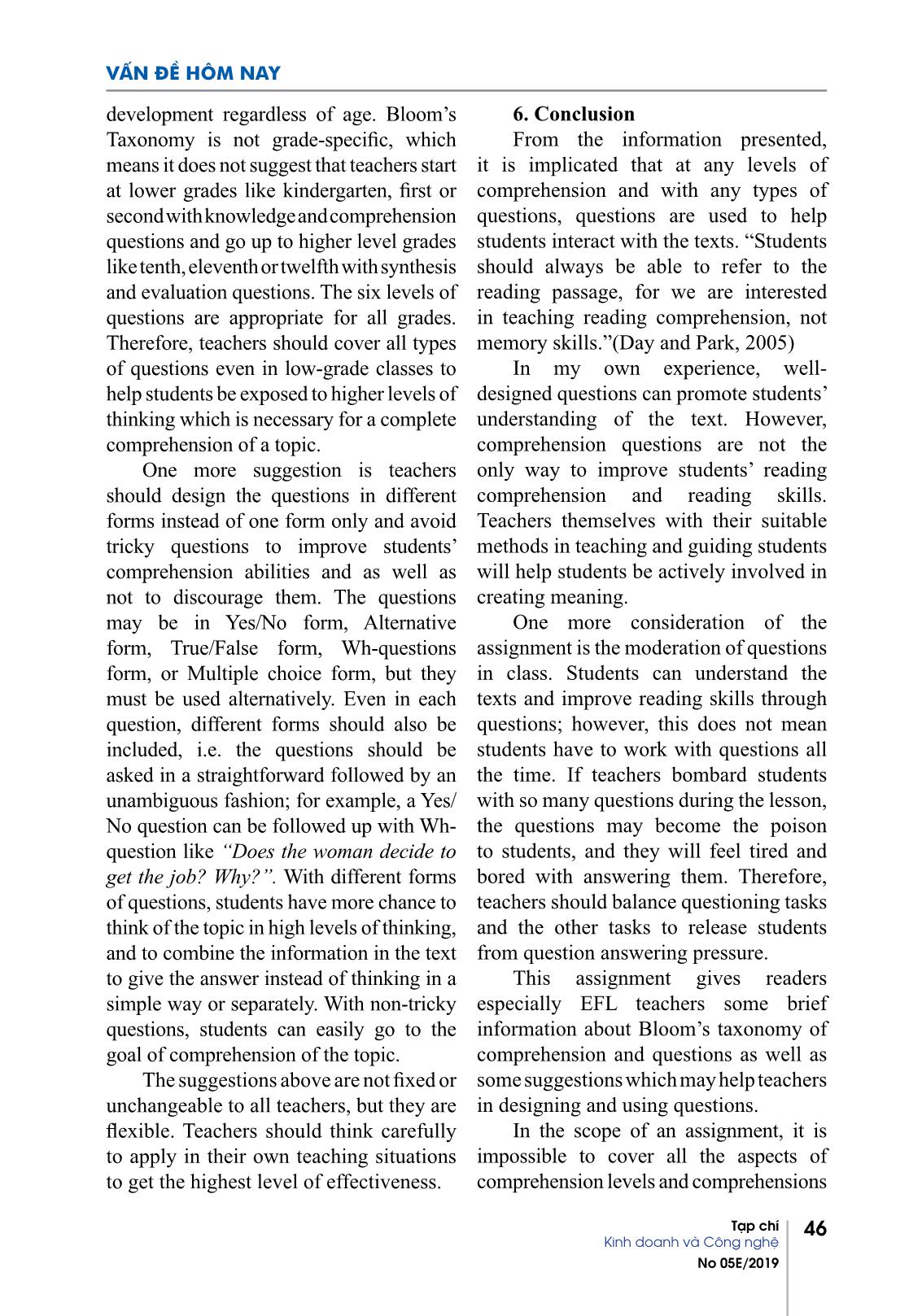
Trang 7
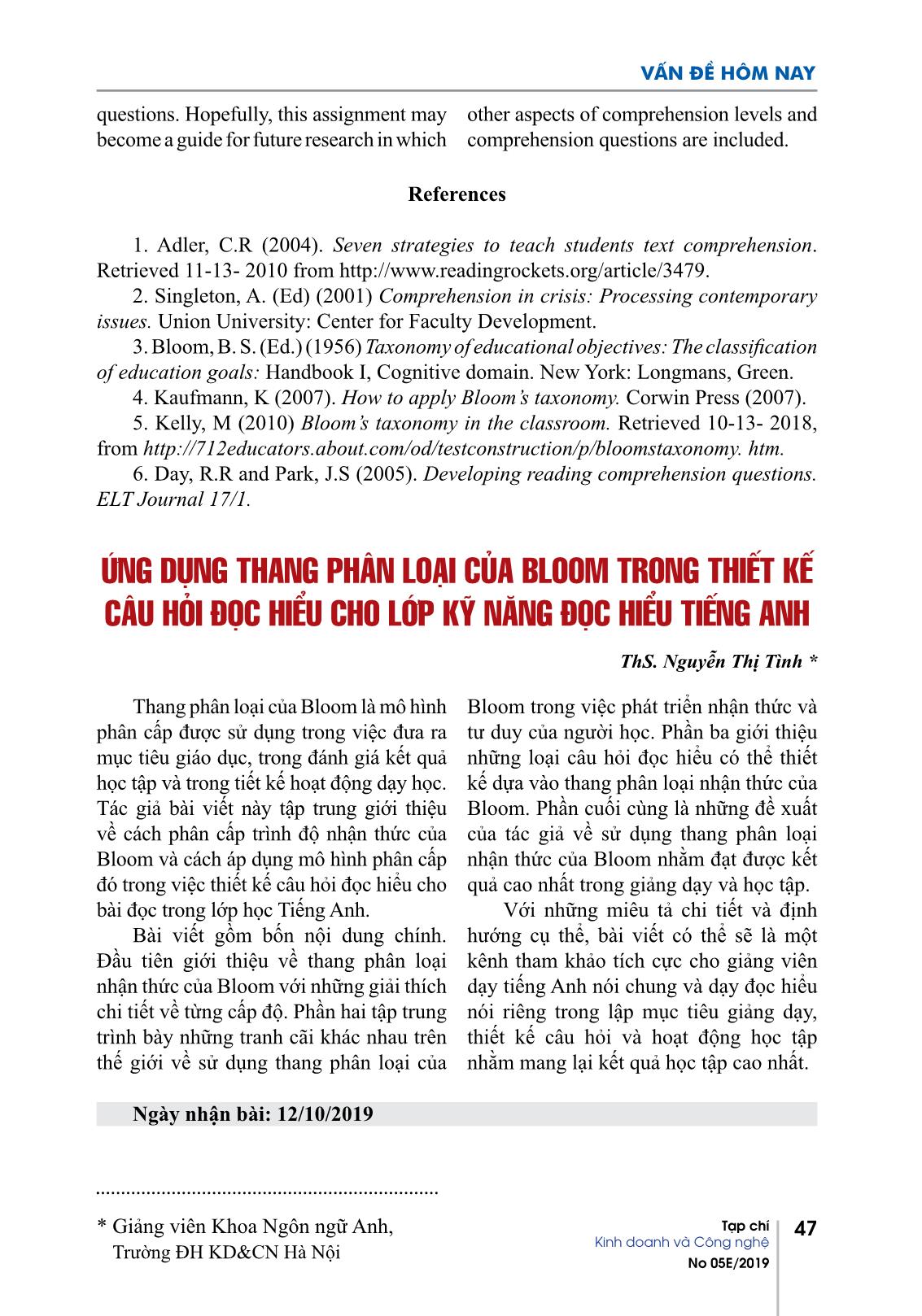
Trang 8
Tóm tắt nội dung tài liệu: Bloom’s taxonomy in designing comprehension questions for reading texts in EFL reading comprehension class
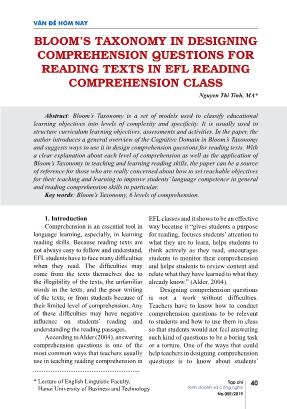
Bloom’s Taxonomy is a model of the stages and progression of critical thinking. Each step requires a higher level of thinking and should be used to meet maximum potential for retention.” Another researcher applying Bloom’s Taxonomy in class is Kelly. She analyzes in her research that Bloom’s Taxonomy has six levels of comprehension and each requires a higher level of abstraction from the students. She suggests teachers should try to move students up the taxonomy as they progress in their knowledge. Teachers should have high expectations concerning students’ abilities. In her research Kelly goes to a conclusion “Building on knowledge and helping kids begin to apply, analyze, synthesize, and evaluate is the key to help them grow in school and beyond.” From 2 research papers above, it can be understood that Bloom’s Taxonomy is very useful in classroom and in developing student’s critical thinking. Using Bloom’s taxonomy as a standard to design activities and tasks in class is a necessary and intelligent choice to teachers. In an English reading class, Bloom’s taxonomy of comprehension levels can be used as the criterion to help teachers design comprehension questions and have students work effectively with the reading texts. From that point, students’ reading comprehension and reading skills can be improved and developed. To help readers have more specific information about types of comprehension questions designed based on Bloom’s Taxonomy, the next part will present 6 types of comprehension questions that teachers can use in each reading lesson to guide students to get closer to the reading texts. 4. Types of questions based on Bloom’s Taxonomy Knowledge questions This is the lowest level of comprehension questions. Those questions require students to identify information basically in the same form it was written in the text. For example: What is the longest river in the world? Who wrote Gone with the wind? Words often used in this level of questions are: know, define, what, name, where, list, when. Comprehension questions Comprehension questions are those asking students to take many bits of information into a single category or group. At this level, the questions require students to combine data together. VẤN ĐỀ HÔM NAY 44Tạp chí Kinh doanh và Công nghệ No 05E/2019 For example: How could you describe ice-cream making process? What is the main idea of the text? Words are usually used in comprehension questions include describe, use your own words, outline, explain, discuss, compare. Application questions Questions in this level often ask students to use the information they already know to apply to a new situation to make the correct answers or to give new results. For example: Can you group by characteristics such as.? What factor would you change if..? Useful words for this type of questions are apply, manipulate, put to use, choose, interpret, demonstrate, construct, illustrate. Analysis questions Analysis questions are questions asking students to break down something into component parts. Students have to identify reasons, causes, or motives for each conclusions or generalization. For example: What are some of the factors that cause..? Why do we call all these animals mammals? Useful words in this type of questions include analyze, why, take part, diagram, simplify, draw conclusion. Synthesis questions Those questions challenge students to engage in creative or original thinking. They stimulate students to produce original ideas and solve problems. For example: How would your life be different if you could breathe under water? Useful words for synthesis questions include compose, construct, design, revise, create, produce. Evaluation questions An evaluation question requires students make an judgment about the value of an idea, a candidate, a work of art, or a solution to a problem. This type of questions does not have the single right answer. For example: Is there a better solution to the problem? Can you please judge the value of penicillin? Useful words in evaluation questions include judge, rate, assess, evaluate, what is the best, value, criticize, compare. The knowledge of students’ comprehension levels and types of comprehension questions would be a beneficial tool for teachers in reading classes. Teachers had better guide students to understand the reading texts and materials by using these questions. The problem concerned is if the questions used are suitable and moderate or not. Designing and applying comprehension questions effectively in each lesson and for each type of students are not easy. Many teachers ask a wide range number of questions for one text in one lesson, but eventually the possibility that students can understand the text thoroughly is often absent. In the last and most important part of this assignment, some suggestions in designing and applying comprehension questions in reading class will be mentioned, and hopefully those suggestions are valuable and useful for EFL teachers in teaching. 5. Suggestions in designing and using comprehension questions for reading texts in an EFL reading class. VẤN ĐỀ HÔM NAY 45Tạp chí Kinh doanh và Công nghệ No 05E/2019 As being stated above, questions may be considered one of the keys helping students understand the reading texts and materials. It can be inferred that having good questions means having the foundation of success in teaching and learning in a reading class. From the understandings of Bloom’s Taxonomy and types of questions together with experiences in teaching and learning of the writer, this part will give some suggestions in designing comprehension questions for a reading text and using those questions in a reading class. First, teachers should have a general thought about students’ levels of comprehension before deciding to write and use the questions. Students’ levels of comprehension lead teachers to the decision which types of questions should be introduced with high proportion and which type should be reduced. If the students are at low level of comprehension like knowledge, comprehension or application, more questions at this levels should be asked and fewer questions of higher levels should be given. Besides, with higher level questions, students should be given more time in answering. In the case of students with higher levels of comprehension, analysis, synthesis and evaluation questions should be exposed and have students answer with more detailed answers. This way of asking and using questions in classes will avoid the situation in which students may find the tasks too easy or too difficult. If the questions are all at low levels, higher level students will feel bored in class or illusive about their abilities. If the questions are all at high levels, low level students may be de-motivated or discouraged in learning. Secondly, questions should be designed in all types instead of only one. If students are asked questions in different types and at different levels of thinking, they will have to apply different ways of thinking to find out the answer. This way will help students be more flexible in thinking and be able to approach the problem from different levels, in different directions and at different stages. Besides, thanks to different types of questions, students can understand more about the topic presented as well as all the aspects of the matter. The next decision that teachers should pay attention to is when to use each type of questions. It is clear that people always understand the problem from the easy level to more complex. Students also understand the reading text in the same order. Teachers should have students understand with simple things before more complex ones, i.e. teachers should start with easy questions (at low levels) so that students would feel elated before moving to more complicated things. Students will step by step raise their own understanding about the text and be well-prepared for more difficult knowledge. This way will help students achieve the text with ease and improve their comprehension level in their mind. If teachers raise the questions in the opposite order, there is no evidence to ensure that students could understand the text or get improvement in reading. One important thing teachers should remember is students at any levels of comprehension or grade can handle high level thinking questions. That is why teachers must not delete any types of questions in each reading text at any grade students. Challenging students through higher-order questioning will help to stimulate learning and enhance brain VẤN ĐỀ HÔM NAY 46Tạp chí Kinh doanh và Công nghệ No 05E/2019 development regardless of age. Bloom’s Taxonomy is not grade-specific, which means it does not suggest that teachers start at lower grades like kindergarten, first or second with knowledge and comprehension questions and go up to higher level grades like tenth, eleventh or twelfth with synthesis and evaluation questions. The six levels of questions are appropriate for all grades. Therefore, teachers should cover all types of questions even in low-grade classes to help students be exposed to higher levels of thinking which is necessary for a complete comprehension of a topic. One more suggestion is teachers should design the questions in different forms instead of one form only and avoid tricky questions to improve students’ comprehension abilities and as well as not to discourage them. The questions may be in Yes/No form, Alternative form, True/False form, Wh-questions form, or Multiple choice form, but they must be used alternatively. Even in each question, different forms should also be included, i.e. the questions should be asked in a straightforward followed by an unambiguous fashion; for example, a Yes/ No question can be followed up with Wh- question like “Does the woman decide to get the job? Why?”. With different forms of questions, students have more chance to think of the topic in high levels of thinking, and to combine the information in the text to give the answer instead of thinking in a simple way or separately. With non-tricky questions, students can easily go to the goal of comprehension of the topic. The suggestions above are not fixed or unchangeable to all teachers, but they are flexible. Teachers should think carefully to apply in their own teaching situations to get the highest level of effectiveness. 6. Conclusion From the information presented, it is implicated that at any levels of comprehension and with any types of questions, questions are used to help students interact with the texts. “Students should always be able to refer to the reading passage, for we are interested in teaching reading comprehension, not memory skills.”(Day and Park, 2005) In my own experience, well- designed questions can promote students’ understanding of the text. However, comprehension questions are not the only way to improve students’ reading comprehension and reading skills. Teachers themselves with their suitable methods in teaching and guiding students will help students be actively involved in creating meaning. One more consideration of the assignment is the moderation of questions in class. Students can understand the texts and improve reading skills through questions; however, this does not mean students have to work with questions all the time. If teachers bombard students with so many questions during the lesson, the questions may become the poison to students, and they will feel tired and bored with answering them. Therefore, teachers should balance questioning tasks and the other tasks to release students from question answering pressure. This assignment gives readers especially EFL teachers some brief information about Bloom’s taxonomy of comprehension and questions as well as some suggestions which may help teachers in designing and using questions. In the scope of an assignment, it is impossible to cover all the aspects of comprehension levels and comprehensions VẤN ĐỀ HÔM NAY 47Tạp chí Kinh doanh và Công nghệ No 05E/2019 questions. Hopefully, this assignment may become a guide for future research in which other aspects of comprehension levels and comprehension questions are included. References 1. Adler, C.R (2004). Seven strategies to teach students text comprehension. Retrieved 11-13- 2010 from 2. Singleton, A. (Ed) (2001) Comprehension in crisis: Processing contemporary issues. Union University: Center for Faculty Development. 3. Bloom, B. S. (Ed.) (1956) Taxonomy of educational objectives: The classification of education goals: Handbook I, Cognitive domain. New York: Longmans, Green. 4. Kaufmann, K (2007). How to apply Bloom’s taxonomy. Corwin Press (2007). 5. Kelly, M (2010) Bloom’s taxonomy in the classroom. Retrieved 10-13- 2018, from htm. 6. Day, R.R and Park, J.S (2005). Developing reading comprehension questions. ELT Journal 17/1. ỨNG DỤNG THANG PHÂN LOẠI CỦA BLOOM TRONG THIẾT KẾ CÂU HỎI ĐỌC HIỂU CHO LỚP KỸ NĂNG ĐỌC HIỂU TIẾNG ANH ThS. Nguyễn Thị Tình * Thang phân loại của Bloom là mô hình phân cấp được sử dụng trong việc đưa ra mục tiêu giáo dục, trong đánh giá kết quả học tập và trong tiết kế hoạt động dạy học. Tác giả bài viết này tập trung giới thiệu về cách phân cấp trình độ nhận thức của Bloom và cách áp dụng mô hình phân cấp đó trong việc thiết kế câu hỏi đọc hiểu cho bài đọc trong lớp học Tiếng Anh. Bài viết gồm bốn nội dung chính. Đầu tiên giới thiệu về thang phân loại nhận thức của Bloom với những giải thích chi tiết về từng cấp độ. Phần hai tập trung trình bày những tranh cãi khác nhau trên thế giới về sử dụng thang phân loại của Bloom trong việc phát triển nhận thức và tư duy của người học. Phần ba giới thiệu những loại câu hỏi đọc hiểu có thể thiết kế dựa vào thang phân loại nhận thức của Bloom. Phần cuối cùng là những đề xuất của tác giả về sử dụng thang phân loại nhận thức của Bloom nhằm đạt được kết quả cao nhất trong giảng dạy và học tập. Với những miêu tả chi tiết và định hướng cụ thể, bài viết có thể sẽ là một kênh tham khảo tích cực cho giảng viên dạy tiếng Anh nói chung và dạy đọc hiểu nói riêng trong lập mục tiêu giảng dạy, thiết kế câu hỏi và hoạt động học tập nhằm mang lại kết quả học tập cao nhất. * Giảng viên Khoa Ngôn ngữ Anh, Trường ĐH KD&CN Hà Nội Ngày nhận bài: 12/10/2019
File đính kèm:
 blooms_taxonomy_in_designing_comprehension_questions_for_rea.pdf
blooms_taxonomy_in_designing_comprehension_questions_for_rea.pdf

